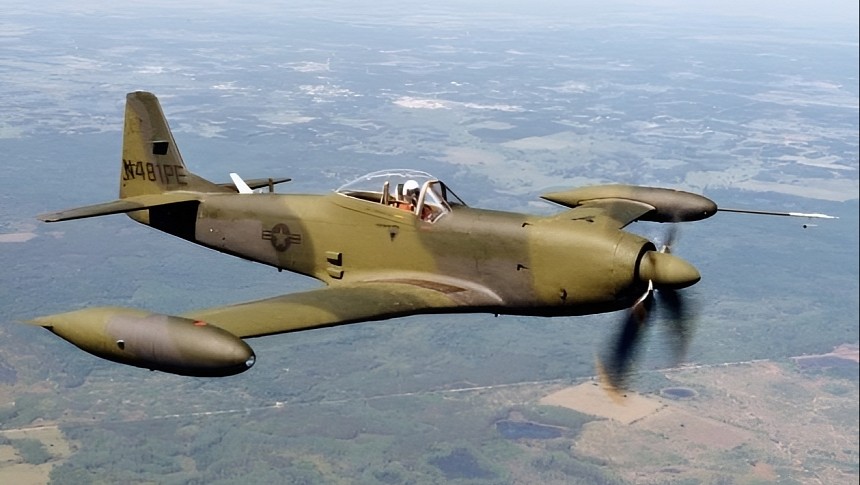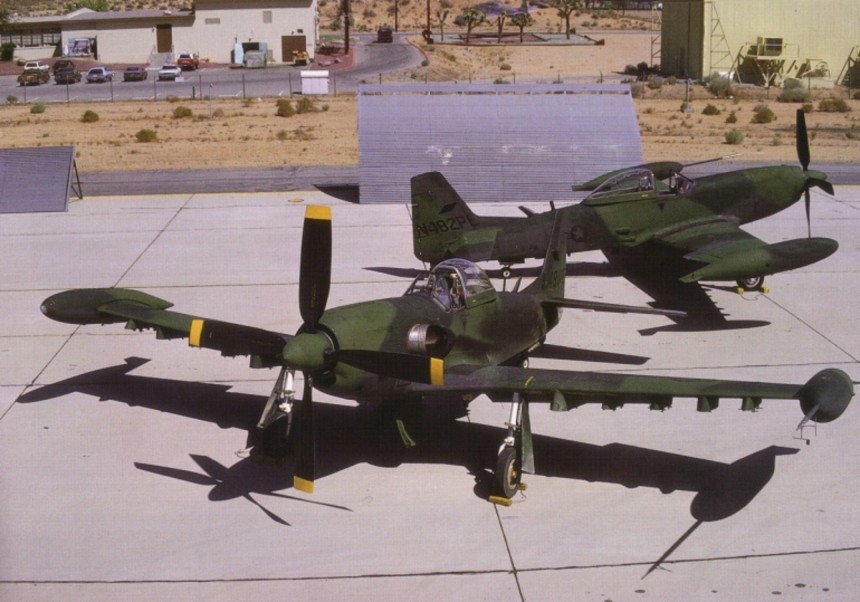If legends never die, then the North American P-51 Mustang is already immortal by all intents and purposes. But this doesn't mean Mustangs could maintain relevancy indefinitely in a military context. But that didn't stop an iconic name in American aviation from trying to find out how much life was left in the Mustang's airframe. This is the story of the Piper PA-48 Enforcer, the all-American P-51 given a thunderous new heart.
But first, a brief backstory regarding the P-51 Mustang's exploits after the end of the Second World War. Because contrary to what most people might think, the Mustang had a pretty successful stint in service with Air Forces across the globe post-1945. After helping the mighty Eighth Air Force lay waste to the German war machine over Europe as well as in Japan, Mustangs continued to form the backbone of the newly founded U.S. Air Force. In the Korean War, Mustang pilots joined the world's first jet fighters in combating communist aggression over the 38th Parallel.
The last operational P-51 was withdrawn from American service with the West Virginia Air National Guard in 1957. But the last documented case of Mustangs in American service came as a chase plane during the development of the Lockheed YAH-56 Cheyenne attack helicopter in 1968. From this point forward, Mustangs continued to operate with Air Forces in the developing world in places like South America, Southeast Asia, and Africa until at least the mid-1980s. All the while, surplus P-51 airframes began to flood the civilian market for anyone with enough cash on hand to do with as they pleased.
One such company that planned to squeeze every ounce of gusto out of a P-51 Mustang's airframe was the Cavalier Aircraft Corporation of Sarasota, Florida. Though initially founded to transform surplus P-51Ds into a bizarre two-seater executive transport plane, only a few examples were sold before the company's focus once again shifted back to military service. Though long obsolete as an escort fighter, Cavalier believed the Mustang would be perfect for a completely different role, that of a counter-insurgency/close air support (CAS) airplane.
With a similar Rolls-Royce-derived Merlin V12 engine as was standard during World War II, the Cavalier Mustang II was fitted with upgraded avionics, structural improvements to the wings, and under-wing hardpoints for a variety of different munitions turned WWII's most famous American dogfighter and made it a proverbial king of CAS. Oh, and we can't forget the six M2 Browning 50-caliber machine guns from the original P-51D. They're still large and in charge, the same as in Mustangs of old. Though a handful of Cavalier Mustang IIs did wind up being sold to El Salvador and Indonesia, a federal mandate preventing the aircraft from carrying wingtip drop-tanks limited its range, snuffing out potential sales.
By the end of the Cavalier Mustang II's days on sale, it was clear the old P-51's Merlin engines had reached the zenith of its aeronautical capability. As far as Cavalier Aircraft's founder David Lindsay was concerned, the best way to get even more life out of a Mustang airframe was to ditch piston engines altogether in favor of a turbine engine. Dubbed the Turbo Mustang III, a single prototype was fitted with the same Rolls-Royce Dart turboprop engine found on the Fokker F-27 Friendship airliner as well as the first generation Grumman Gulfstream I business plane. Later variants received a Lycoming/AvcoT55 turboprop engine famous for powering the Boeing Chinook Helicopter.
With 2,445 shaft horsepower on offer, it's roughly 1130 more than what you'd get out of a Merlin V-1650-7. But the Turbo Mustang III's top speed of just 345 mph (555 kph, 300 knots) denotes this warbird is no speed demon. Instead, the aircraft was built to fly low and slow over scattered and chaotic battlefields eliminating enemy ground personnel and light armored vehicles while keeping the area secure for friendly ground forces. The Turbo Mustang III made its first flight in April 1971, after which Cavalier sold the design to the historic Piper Aircraft, Inc to mass produce the aircraft.
Ultimately, the re-named Piper PA-48 Enforcer was only manufactured four times. One prototype fitted with the Rolls-Royce Dart engine, two dual-seat, dual-control examples, one of which was lost in a 1971 accident, and a single one-seater example more in line with what would have been manufactured had the Enforcer garnered a military contract. In truth, only around ten percent of the PA-48's airframe had anything in common with the old P-51D' Mustang by the time Congress approved an $11.9 defense contract to test the aircraft in 1979.
For the next five years, the project was overseen by a U.S. Air Force evaluation team while being test flown by Piper's own corporate pilots. Though no doubt capable in its role, test flights over Edwards Air Force Base in California failed to net the PA-48 any more interest from the Pentagon. The program was quietly withdrawn from service in 1984, and two are currently known to be in the hands of private museums. One is on display at the Air Force Flight Test Museum at Edwards Air Force Base, while another is in the collection of the Pima Air and Space Museum in Tucson, Arizona.
The last operational P-51 was withdrawn from American service with the West Virginia Air National Guard in 1957. But the last documented case of Mustangs in American service came as a chase plane during the development of the Lockheed YAH-56 Cheyenne attack helicopter in 1968. From this point forward, Mustangs continued to operate with Air Forces in the developing world in places like South America, Southeast Asia, and Africa until at least the mid-1980s. All the while, surplus P-51 airframes began to flood the civilian market for anyone with enough cash on hand to do with as they pleased.
One such company that planned to squeeze every ounce of gusto out of a P-51 Mustang's airframe was the Cavalier Aircraft Corporation of Sarasota, Florida. Though initially founded to transform surplus P-51Ds into a bizarre two-seater executive transport plane, only a few examples were sold before the company's focus once again shifted back to military service. Though long obsolete as an escort fighter, Cavalier believed the Mustang would be perfect for a completely different role, that of a counter-insurgency/close air support (CAS) airplane.
With a similar Rolls-Royce-derived Merlin V12 engine as was standard during World War II, the Cavalier Mustang II was fitted with upgraded avionics, structural improvements to the wings, and under-wing hardpoints for a variety of different munitions turned WWII's most famous American dogfighter and made it a proverbial king of CAS. Oh, and we can't forget the six M2 Browning 50-caliber machine guns from the original P-51D. They're still large and in charge, the same as in Mustangs of old. Though a handful of Cavalier Mustang IIs did wind up being sold to El Salvador and Indonesia, a federal mandate preventing the aircraft from carrying wingtip drop-tanks limited its range, snuffing out potential sales.
With 2,445 shaft horsepower on offer, it's roughly 1130 more than what you'd get out of a Merlin V-1650-7. But the Turbo Mustang III's top speed of just 345 mph (555 kph, 300 knots) denotes this warbird is no speed demon. Instead, the aircraft was built to fly low and slow over scattered and chaotic battlefields eliminating enemy ground personnel and light armored vehicles while keeping the area secure for friendly ground forces. The Turbo Mustang III made its first flight in April 1971, after which Cavalier sold the design to the historic Piper Aircraft, Inc to mass produce the aircraft.
Ultimately, the re-named Piper PA-48 Enforcer was only manufactured four times. One prototype fitted with the Rolls-Royce Dart engine, two dual-seat, dual-control examples, one of which was lost in a 1971 accident, and a single one-seater example more in line with what would have been manufactured had the Enforcer garnered a military contract. In truth, only around ten percent of the PA-48's airframe had anything in common with the old P-51D' Mustang by the time Congress approved an $11.9 defense contract to test the aircraft in 1979.
For the next five years, the project was overseen by a U.S. Air Force evaluation team while being test flown by Piper's own corporate pilots. Though no doubt capable in its role, test flights over Edwards Air Force Base in California failed to net the PA-48 any more interest from the Pentagon. The program was quietly withdrawn from service in 1984, and two are currently known to be in the hands of private museums. One is on display at the Air Force Flight Test Museum at Edwards Air Force Base, while another is in the collection of the Pima Air and Space Museum in Tucson, Arizona.

